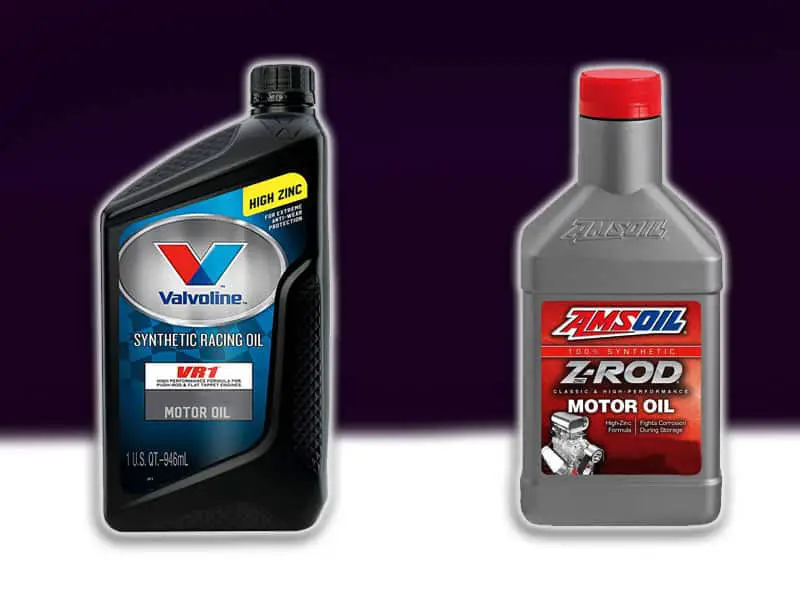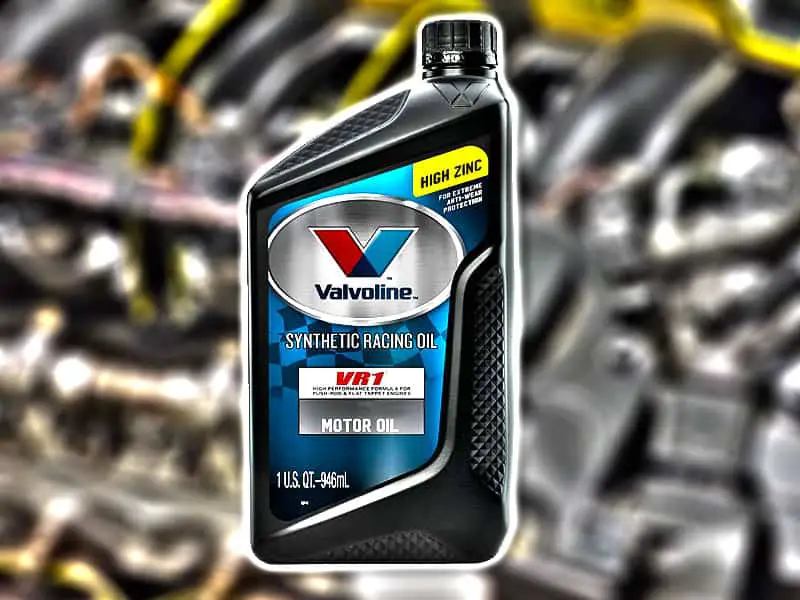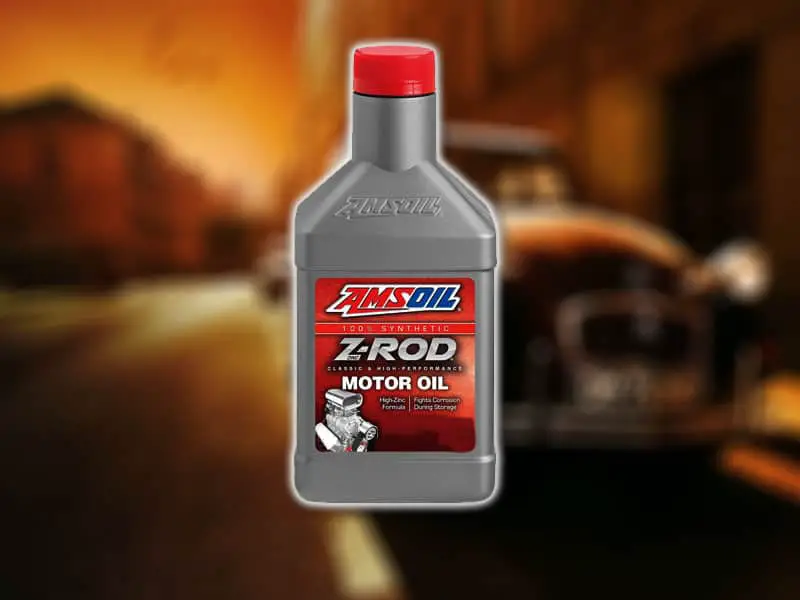Valvoline VR1 and Amsoil Z ROD are both fully synthetic motor oils designed to be used in high-performance gasoline engines, where Z ROD is also suitable for older or modified classic car engines.
VR1 is catalytic converter friendly due to the presence of lower quantities of zinc and phosphorus. It has great cleaning ability thanks to its highly effective detergents. It provides better oil burn-off protection since its flash point temperature is higher. It has higher kinematic viscosities at both medium and high temperatures. This oil offers a higher viscosity index and a lower pour point temperature.

Z ROD is known for its maximum rust and corrosion prevention. It uses a mixture of rust and corrosion inhibitors to prevent any sludge buildup. This oil also uses a vast amount of zinc and phosphorus anti-wear additives to protect all areas of the engine. Moreover, it also offers unmatched oxidation prevention.
| Specifications | Valvoline VR1 | Amsoil Z ROD |
| Oil Type | Fully Synthetic | Fully Synthetic |
| Engine Type | Gasoline | Gasoline |
| Available viscosity grades | 10W-30, 20W-50, SAE 30, SAE 40, SAE 50, SAE 60 | 10W-30, 10W-40, 20W-50 |
| ILSAC | Unavailable | Unavailable |
| API | SN, SM, SL, SJ | SM, SL, SJ |
| Cost (1 Quart.) | 12.72$ | 20.78$ |
| Oil change frequency (Km) | 4800 | 8000 |
| Additives | Anti-wear, Anti-foam additives, Detergents, Dispersants | Anti-wear, Detergents, Dispersants, Anti-foam additives, Anti-oxidants |
| ACEA | A3/B4 | Unavailable |
Table of Contents
Engine Wear-Off Protection Comparison

Anti-wear additives are responsible for protecting the engine from wearing.
They form a thin lubricative layer around different metallic parts of the engine, thus preventing friction.
VR1 uses decent amounts of zinc and phosphorus additives to protect against engine wear.
This oil also contains moderate amounts of boron and molybdenum which also act as anti-wear additive but still, it is no match against its competitor in terms of engine wear-off protection.
Z ROD also uses the same anti-wear additives i.e., zinc and phosphorous to lubricate different parts of the engine.

Although the quantities of molybdenum and boron used in this oil are lower, still it offers better wear-off protection due to the higher amounts of zinc and phosphorus which are its main anti-wear additives.
| Oils in Comparison (10W-30 Grade oils) | Zinc Concentration (ppm) | Phosphorus Concentration (ppm) | Boron Concentration (ppm) | Molybdenum Concentration (ppm) |
| Valvoline VR1 | 1140 | 1200 | 205 | 66 |
| Amsoil Z ROD | 1442 | 1313 | 15 | 60 |
What their Viscosity tell us?
The viscosity of an oil is the measure of its flowing capabilities under different temperatures. The viscosity index determines the change that occurs in the viscosity of motor oil as the temperature changes. The higher the viscosity index, the lesser the oil’s flow is affected by the change of temperature. Another factor to keep in mind when comparing viscosities is the pour point temperature of the oil. Pour point refers to the temperature below which the oil loses its ability to flow.
VR1 has higher kinematic viscosities than its peer at both 40 and 100 degrees Celsius.
That’s why it has a higher viscosity index. This oil has a lower pour point temperature compared to its contender meaning it would freeze later in extreme cold.
Z ROD’s kinematic viscosity is lower than that of its rival at 40 degrees Celsius. Similarly, the drop in its kinematic viscosity is great at 100 degrees Celsius. Hence it has a lower viscosity index. This oil has a higher pour point temperature which means it will freeze before its counterpart in cold weather.
| Oils in Comparison (10W-30 Grade oils) | Kinematic Viscosity @ 40 o C (cSt) | Kinematic Viscosity @ 100 o C (cSt) | Viscosity index (VI) | Pour point (Degrees Celsius) |
| Valvoline VR1 | 94.20 | 14.50 | 160 | -44 |
| Amsoil Z ROD | 74.9 | 11.8 | 152 | -42 |
Are they friends with the Catalytic Converter?
High levels of zinc and phosphorus present in an oil cause harmful effects to the catalytic converter. These additives burn off to produce zinc and phosphate ash that settles onto the catalytic converter and drastically reduce its efficiency of conversion.
VR1 has comparatively lower amounts of zinc and phosphorous additives so it is well-suited for vehicles using catalytic converters.
Z-ROD contains massive quantities of zinc and phosphorous additives. Thus, this oil can cause damage to catalytic converters.
| Oils in Comparison (10W-30 Grade oils) | Zinc Concentration (ppm) | Phosphorus Concentration (ppm) |
| Valvoline VR1 | 1140 | 1200 |
| Amsoil Z ROD | 1442 | 1313 |
Do they keep your engine clean?
The oxidized oil combines with water, dirt, and other contaminants to form a sticky and thick gel-type substance known as sludge. Its formation can lead to several problems such as power loss, higher fuel consumption and even stalling of the engine. Detergents are added to the oil to clean sludge.
VR1 uses a combination of calcium and magnesium additives to keep the engine clean. Its calcium quantity is a little lower than other oil. This is overcomed by the combination of a higher quantity of magnesium along with calcium which leads to better prevention of sludge build-up compared to its counterpart.
Z ROD mainly relies on calcium as its main detergent which is present in higher quantity. There is also some amount of magnesium present but it doesn’t affect its performance that much. That’s why this oil is not as good as its competitor when it comes to fighting off sludge formation.
| Oils in Comparison (10W-30 Grade oils) | Magnesium Concentration (ppm) | Calcium Concentration (ppm) |
| Valvoline VR1 | 760 | 2720 |
| Amsoil Z ROD | 11 | 2747 |
Oil-burn off Protection Comparison
Oil burn-off can be determined using its flash point temperature. Flash point temperature means the temperature at which the vapors of the liquid ignites. A lower flash point would mean the liquid burns off quicker and vice versa.
VR1 has a higher flash point temperature. Therefore, this oil offers better protection against early burn-off.
Z ROD has a decent flash point temperature but it is lower comparatively. So, its burn-off protection is lesser compared to its counterpart.
| Oils in Comparison (10W-30 Grade oils) | Flash Point Temperatures (Degrees Celsius) |
| Valvoline VR1 | 248 |
| Amsoil Z ROD | 232 |
Oil Change Frequency Comparison
The oil change interval of the oil depends on its TBN. TBN (Total base number) refers to the base additives present in the oil that can neutralize organic and inorganic acids formed in the engine during the combustion process. The higher the TBN, the longer is the oil change interval and vice versa.
Valvoline VR1 has a lower TBN compared to the Z ROD. Thus, it offers a lesser oil change interval of around 4800 km. While Z ROD with a higher TBN and has an oil change interval of around 8000 km.
| Oils in Comparison (10W-30 Grade oils) | TBN (Total Base Number) mg KOH/g |
| Valvoline VR1 | 7.2 |
| Amsoil Z ROD | 10.1 |
Quick Summary
- Both these oils are fully synthetic and are recommended to be used in high-performance gasoline engines.
- VR1 has many viscosity grade options compared to the Z ROD.
- VR1 is less damaging to catalytic converters.
- VR1 is better when it comes to sludge build-up protection
- VR1 offers better oil burn-off protection.
- Z ROD provides better engine wear-off protection.
- VR1 has a higher kinematic viscosity at both 40 and 100 degrees Celsius and also offers a higher viscosity index. Whereas, Z ROD provides a higher pour point temperature.
- Z ROD offers longer oil change intervals.
- VR1 is cheaper compared to its counterpart.